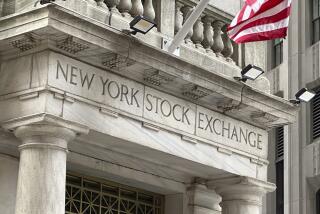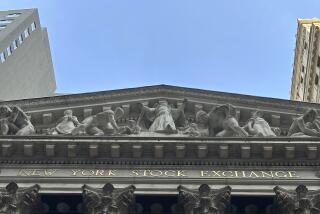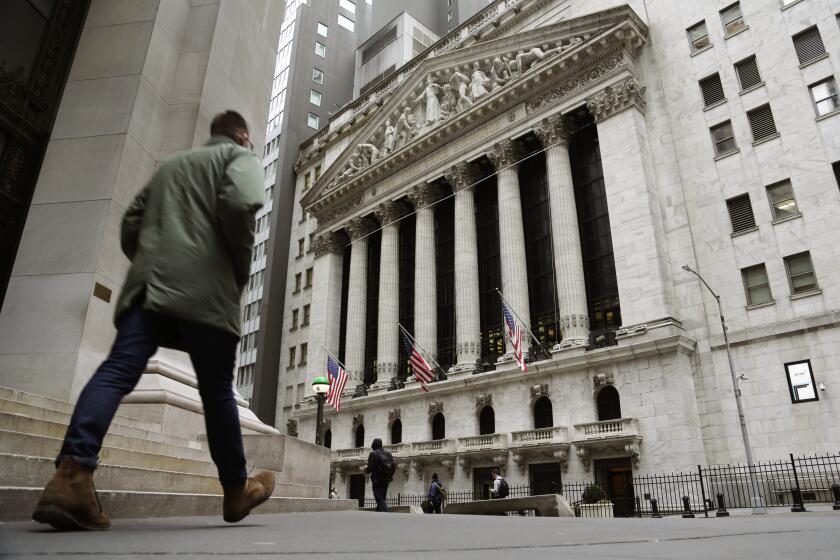Gold-Mining Firms, Growth Funds Among Biggest Losers in Crash
- Share via
Some of the bull market’s biggest mutual fund winners now are among the bear market’s biggest losers, data released last week shows.
Mutual funds that invest in stocks of small growth companies and gold-mining firms--which had been among the bull market’s stalwarts--were among several groups of funds that lost more on average than the market as a whole since late August, according to Lipper Analytical Services, a New York firm that tracks mutual funds.
On the other hand, some of the bull market laggards--funds investing in bonds, other fixed-income securities, utilities and high-dividend paying stocks--did best in minimizing losses.
“People who had felt that these funds missed the boat during the bull market now see the role of these types of conservative approaches to investing,” said Joe Mansueto, president of Morningstar Inc., a Chicago fund-tracking firm. “Avoiding losses is the key to building wealth,” Mansueto added.
“It was a mirror image,” Lipper Analytical President A. Michael Lipper said.
Poorest Performers
The data gives a clue to what funds might perform better if stocks can’t sustain their recent rallies and remain in a bear market for some time. Traditionally, funds that do best in a bull market often invest in more speculative stocks or use riskier trading strategies. They often pay off when stocks are raging upward but flop in a bear market.
A good illustration of this was the dismal performance of 44 Wall Street Equity and its sister fund, 44 Wall Street. They plummeted 63.70% and 50.86%, respectively, making them the worst losers since late August on Morningstar’s list. Both funds invest in only a handful of stocks, making their portfolios far less diversified than most equity funds.
Other less diversified funds also fared poorly. Many of the so-called sector funds offered by Fidelity Investments, the nation’s largest fund company, filled Morningstar’s worst-performing list. These sector funds invest only in stocks of certain industries.
The list of worst-performing fund groups was topped by funds that invest in small growth companies usually traded on the over-the-counter market, which has been particularly hard hit by the market crash. That group declined 32.81%, according to Lipper.
Next worst were funds investing in science and technology stocks (off 31.19%), funds investing in health-care firms (minus 30.87%), funds investing in energy and other natural resource companies (down 30.35%) and funds investing in gold-mining concerns (off 28.25%), Lipper said.
One Group Gains
The data also show that many of the nation’s biggest funds posted among the worst performances in the crash. The nation’s largest fund, Fidelity Magellan, fell 34.93% between Aug. 25 and Tuesday, compared to a 30.37% fall in the Standard & Poor’s 500-stock index, Morningstar said. Magellan’s strategy of remaining fully invested in stocks, including many foreign and over-the-counter stocks, paid off well during the bull market but struck out in the stock debacle.
Only one group of mutual funds, those investing in foreign bonds, managed to gain in value (up 1.98%) since the late August peak, Lipper’s data shows. The next best performers were fixed-income funds, which invest in bonds and other fixed-income securities. They were down only 1.95%.
Other groups that fared reasonably well were funds that invest in utilities stocks and so-called balanced funds that invest in bonds and high-dividend paying stocks. Stocks with high dividends, such as utilities, often are investor favorites in down markets because their dividends provide steady income to cushion against declines in prices.
Understandably, equity funds that were heavily in cash in anticipation of a downturn weathered the crash much better than their counterparts that were more fully invested in stocks. For example, Rightime Blue Chip and its sister, Rightime Fund, topped Morningstar’s list with a gain of 0.76% and a loss of 0.4%, respectively. Both had the bulk of their assets in cash, Mansueto said.
The data did have one silver lining. Equity funds had been criticized during the 1982-87 bull market for consistently not beating the S&P; 500. But so far in the bear market, equity funds are outperforming the S&P; 500. The funds have fallen only 25.80%, versus about 26.72% for the index, according to Lipper.
HOW BIGGEST MUTUAL FUNDS HAVE FARED SINCE AUGUST
For period from Aug. 25 through Oct. 27. Ranked in order of asset size.
% Fidelity Magellan -34.93 Windsor Fund -23.75 Fidelity Puritan -20.11 Investment Co. of America -25.35 Pioneer II -32.06 Templeton World -26.35 Fidelity Equity Income -23.47 Affiliated -27.92 Merrill Lynch Ret.-Full Inv. -17.30 American Capital Pace -35.19 S&P; 500 (dividends reinvested) -30.37%
Source: Morningstar Inc.
HOW MUTUAL FUND GROUPS HAVE FARED SINCE AUGUST
For period from Aug. 20 through Oct. 29. Includes dividends plus reinvested capital gains
% World income funds +1.98 Fixed-income funds -1.95 Option growth funds -2.62 Income funds -8.05 Utility funds -10.17 Balanced funds -15.82 Equity income funds -16.99 Convertible securities funds -19.67 Option income funds -21.17 International funds -21.77 Growth and income funds -22.79 Global funds -24.31 Growth funds -27.48 Capital appreciation funds -27.59 Specialty funds -28.02 Gold-oriented funds -28.25 Natural resources funds -30.35 Health funds -30.87 Science and technology funds -31.19 Small company growth funds -32.81 All funds average -18.18% S&P; 500 (dividends reinvested) -26.72%
Source: Lipper Analytical Services
More to Read
Inside the business of entertainment
The Wide Shot brings you news, analysis and insights on everything from streaming wars to production — and what it all means for the future.
You may occasionally receive promotional content from the Los Angeles Times.










